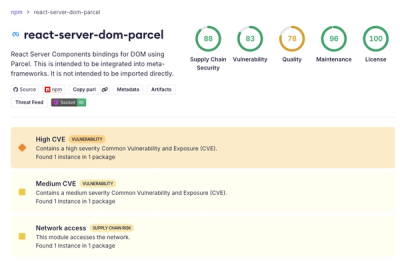
Security News
New React Server Components Vulnerabilities: DoS and Source Code Exposure
New DoS and source code exposure bugs in React Server Components and Next.js: what’s affected and how to update safely.
docker-map
Advanced tools
Project: https://github.com/merll/docker-map
Docs: https://docker-map.readthedocs.io/en/latest/
This package provides tools for building Docker images, create containers, connect dependent resources, and run them in development as well as production environments.
The library builds on functionality of the Docker Remote API client for
Python, docker-py. Its main target is to reduce the repetitive and
error-prone code that is required for creating and connecting containers
in a non-trivial stack. It can be used standalone for custom
orchestration or for enhancing available deployment / remote execution
utilities (see
Docker-Fabric <https://github.com/merll/docker-fabric>, Salt Container-Map <https://github.com/merll/salt-container-map>).
Containers and their dependencies are configured object-based, through Python dictionaries, or YAML files.
Writing Dockerfiles is not hard. However, it only allows for using variable context to a limited extent. For example, you may want to re-define directory paths in your project, without having to adjust it in multiple places; or you keep frequently reoccurring tasks (e.g. creating system user accounts) in your Dockerfile, and would like to use templates rather than copy & paste.
A DockerFile object generates a Dockerfile, that can either be saved
locally or sent off to Docker through the remote API. Supports common
commands such as addfile (ADD) or run, but also formats
CMD and ENTRYPOINT appropriately for running a shell or exec
command.
DockerContext generates a Docker context tarball, that can be sent
to the remote API. Its main purpose is to add files from DockerFile
automatically, so that the Dockerfile and the context tarball are
consistent.
This package reduces repetitions of names and paths in API commands, by introducing the following main features:
ContainerConfiguration objects keep the elements of a configured
container. Their main elements are:
image: Docker image to base the container on (default is
identical to container name).clients: Optional list of clients to run the identical container
configuration on.instances: Can generate multiple instances of a container with
varying host mappings; by default there is one main instance of each
container.shares: Volumes that are simply shared by the container, only for
the purpose of keeping data separate from the container instance, or
for linking the entire container to another.binds: Host volume mappings. Uses alias names instead of
directory paths.uses: Can be names of other containers, or volumes shared by
another volume through attaches. Has the same effect as the
volumes_from argument in the API, but using alias names and
automatically resolving these to paths.links: For container linking. Container names are translated to
instance name on the map.attaches: Generates a separate container for the purpose of
sharing data with another one, assigns file system permissions as set
in permissions and user. This makes configuration of sockets
very easy.exposes: Configures port bindings for linked containers and on
host interfaces.exec_commands: Launches commands on containers after they have
been created and started.create_options and host_config provide the possibility to add
further keyword arguments such as command or entrypoint,
which are passed through to the docker-py client.ContainerMap objects contain three sets of elements:
ContainerConfiguration.Clients, as defined in a ContainerConfiguration, can also be set
globally on map level.
ContainerConfiguration instances and their elements can be created
and used in a dictionary-like or attribute syntax, e.g.
container_map.containers.container_name.uses or
container_map.containers['container_name']['uses']. Volume aliases
are stored in container_map.volumes and host binds in
container_map.host; they support the same syntax variations as
containers.
ClientConfiguration objects allow for a host-specific management of
parameters, such as service URL and timeout. For example, the
interfaces property translates the exposes setting for a
configuration on each host into a port binding argument with the local
address.
MappingDockerClient applies one or multiple ContainerMap
instances to one or multiple Docker clients. A container on the map can
easily be created with all its dependencies by running
client.create('container_name').
Running the container can be as easy as
client.start('container_name') or can be enhanced with custom
parameters such as client.start('container_name', expose={80: 80}).
If all configuration is stored on the map, creation and start are
combined in client.startup('container_name').
FAQs
Managing Docker images, containers, and their dependencies in Python.
We found that docker-map demonstrated a healthy version release cadence and project activity because the last version was released less than a year ago. It has 1 open source maintainer collaborating on the project.
Did you know?

Socket for GitHub automatically highlights issues in each pull request and monitors the health of all your open source dependencies. Discover the contents of your packages and block harmful activity before you install or update your dependencies.

Security News
New DoS and source code exposure bugs in React Server Components and Next.js: what’s affected and how to update safely.

Security News
Socket CEO Feross Aboukhadijeh joins Software Engineering Daily to discuss modern software supply chain attacks and rising AI-driven security risks.

Security News
GitHub has revoked npm classic tokens for publishing; maintainers must migrate, but OpenJS warns OIDC trusted publishing still has risky gaps for critical projects.